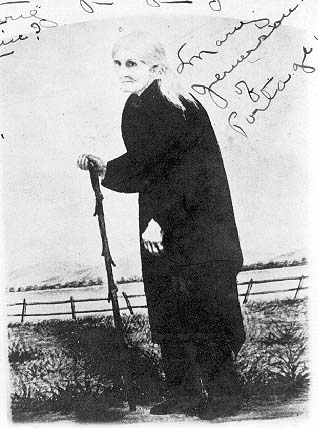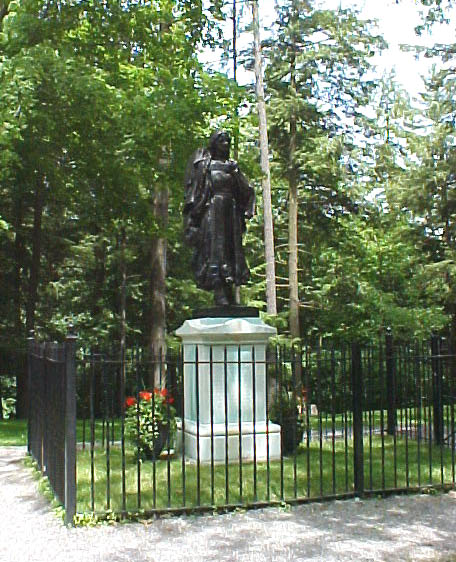
In the fall of 1743, somewhere on the stormy Atlantic, a child was born to Thomas and Jane Jemison aboard the ship William and Mary. The little baby girl was named Mary, and although she was not aware of it, she was joining her parents and brothers and sisters on a voyage to the New World.
The Jemison family landed in Philadelphia and soon joined the other Scotch-Irish immigrants on the western frontier, a place that promised them cheap land and freedom. Thomas Jemison took his family to the Marsh Creek settlement near South Mountain (not far from present day Gettysburg PA), raised a cabin, and began to build a new life.
Although life was hard on the western edge of the colony of Pennsylvania, Mary fondly recalled these "childish, happy days" full of hard work and the love of a family that now number six children. But when Mary was fifteen, these happy times came to a tragic end.
The French and Indian War was raging throughout the English Colonies and Canada. It was a bitter struggle between two European powers, and colonies and native people of both sides suffered. Those on the frontier suffered the most.
In the spring of 1758 a raiding party of French soldiers and Shawnee warriors descended upon the frontier region that included Marsh Creek. On Wednesday, April 5th, they swept over the little clearing where the Jemison's lived. The two oldest boys escaped, but Mary, her parents, and the rest of the family were taken captive.
The raiding party headed west toward Fort Duquesne (Pittsburgh). The decision was made to lighten their load since they had too many captives to outrun the pursing militia. At nightfall they separated a tearful Mary from her family, along with a neighbor boy who had also been captured, and led them away. The rest of the Jemison family were killed and scalped.
At Ft Duquesne Mary was purchased by a party of Senecas who loaded her in a canoe and headed down the Ohio. When she arrived at the village, she found herself in a very different world; the world of the Seneca people. They adopted the teenager, throwing her old name, clothing, and existence in the Ohio, and wrapping her in her name identity. She was now Dehgewanus, or "Two Falling Voices".
Over the next years Dehgewanus learned the Senecas ways. She took a Delaware husband, Sheninjee. A little girl was born to them in the summer of 1761, but died soon after birth. Before the next spring she gave birth again, this time to a son which she named "Thomas" after her father who she still missed terribly.
That summer, with her baby in the cradleboard on her back, Dehgewanus and Shenijee started a remarkable journey. Shenijee worried that the end of the war would mean a return of captives, it was possible that he might lose his young wife. They would go to his homeland along the Genesee River near a Valley called Sehgahunda.
The journey was long and hard, almost seven hundred miles by the route they took. Finally in the dead of winter did Dehgewanus reach the Genesee, but without Shenijee. He had separated from Dehgewanus to do some hunting and trapping, and took ill and died. Dehgewanus, now a widow, was in a strange new land.
But Shenijee's clan relatives soon made a home for her at Little Beard's Town near present day Cuylerville New York. This was the heartland of the Seneca People, keeper of the Western Door of the Iroquois League, and life along the Genesee was good. She remarried to Hiokatoo, with whom she would have six more children. This was, she remembered, a time when she and her adopted people "lived quietly and peaceably."
That peace was shattered by the Revolutionary War. The Senecas and several of the other tribes sided with the British, and became the targets of the American Army. In 1779 George Washington sent an army of five thousand soldiers to destroy the Seneca's will and ability to fight. Their main target was Little Beard's Town.
The Seneca hoped to stop the invaders with a well laid ambush, but despite losses, the American's reached the Genesee Valley and began to burn the fields and homes of the inhabitants. As they approached Little Beard's Town, the Seneca fled into the forest. Many others flooded the Seneca villages untouched by the Army, but Dehgewanus made the decision to go to the abandoned village of Gadaho, south of little Beardstown. There she and her children found shelter with two runaway slaves, and there she would live for nearly sixty years.
Along the banks of the Genesee, Dehgewanus returned to her Seneca ways. Hiokatoo found her there and together they rebuilt their lives. For nearly twenty years they lived there until the white man invaded once more. This time the invading army was made up of land speculators and pioneers, not soldiers.
A great council was held at the Big Tree near present day Geneseo New York in the late summer of 1797. All the Seneca leaders were there, along with the women who would, in their tradition way, advise them. The negotiations were long and difficult, and the resulting treaty pleased few of those that were there. In return for twelve reservations and payments, much of the Seneca homeland was turned over for sale to settlers.
One of those reservations included the lands where Dehgewanus and her family lived. She had journeyed to Big Tree and had been able to get some lands set aside. The resulting Gardeau Reservation, when it was later surveyed, consisted of nearly eighteen thousand acres.
Although they still had their land to grow their corn, beans, and squash, the Seneca who remained in the Valley found themselves struggling to survive in an increasingly white world. Dehgewanus and her family paid a heavy price, for the pressures and tensions of the times took three of the Jemison boys; all three murdered between 1811 and 1817. During the same period area residents tried several times to deprive Dehgewanus of her lands.
Most of her neighbors, however, respected the Seneca woman they called the "Old White Woman of the Genesee". They knew that no one in need was ever turned away from her cabin door, and they looked forward to the times when she came to their little cabins for tea and cakes. Some local residents even encouraged a doctor and writer to talk with the Old White Woman. The interview took place in November of 1823 at a place called Whaley's Tavern. The next year a little book titled "The Life and Times of Mrs. Mary Jemison" was published, preserving the story of Dehgewanus forever.
In 1823 the
Senecas gave up the Gardeau lands, reserving two square miles
for Dehgewanus' use. She sold the title to the lands in 1831 and
moved to the Buffalo Creek Reservation. There "Two Falling
Voices", Dehgewanus and Mary Jemison, was stilled on September
19, 1833.
Forty-one years later the Old White Woman returned to her Valley. The Buffalo Creek Reservation had been sold, and the old burying ground was threatened. Her grandchildren approached Mr. Letchworth to see if he could help them. He immediately invited them to bring the bones of their grandmother to his Glen Iris Estate. In March of 1874, the remains of Dehgewanus were removed from her original grave, placed in a new walnut coffin, and brought to the Genesee by train. In ceremonies held in the ancient Council House that blended both the Seneca and Christian ways, Dehgewanus was buried on the bluff above the Middle Falls.
Visitors to Letchworth Park can still visit the "Old White Woman of the Genesee". A granite marker, erected by Mr. Letchworth not long after the reburial, marks her grave. (The original stone from Buffalo Creek can still be found in the Park Museum). On top of the marker is the famous Mary Jemison statue that Mr. Letchworth dedicated to her memory in 1910. It depicts the young Dehgewanus, with Thomas on her back; making the long trek from the Ohio to the Genesee Valley; an unforgettable journey in the amazing life of a remarkable woman that walked in two worlds.
(Left: The Mary Jemison Grave and Statue at the Council Grounds, restored in 2006)
Also see
Photograph of the Mary Jemison Statue
Jemison Cabin on the Council Grounds
and additional primary and secondary material on Mary Jemison in our "Pieces of the Past" including a timeline, contemporary accounts, and much more!
Tom Cook
Sources:
Seaver, Life of Mrs. Mary Jemison